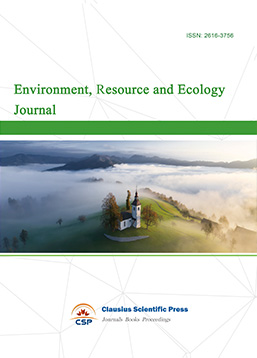MONITORING OF VEGETATION CHANGE BY USING RS AND GIS TECHNIQUES IN MITROVICA, KOSOVO
DOI: 10.23977/jcgis.2018.11001 | Downloads: 117 | Views: 8096
Author(s)
Edon Maliqi 1,2, Petar Penev 2
Affiliation(s)
1 “Geo - SEE Institute” branch office in Kosovo. Pristina, Kosovo
2 University of Architecture, Civil Engineering and Geodesy. Sofia, Bulgaria
Corresponding Author
Edon MaliqiABSTRACT
Monitoring environment changes has become a necessity as a result of current environment deteriorating due to human activities like mining activities. In most developing countries like Kosovo (Mitrovica), acquiring information concerning the current condition and the dynamic changes of the environment for a rapid monitoring is not easy. The present study provides The Normalized Difference vegetation Index (NDVI) of the study area, Mitrovica. The main aim of the study is to monitor and evaluate changes in vegetation over the years, using NDVI time series outputs. As well as this technique of monitoring vegetation will be used to evaluate drying vegetation as e result of the mining tailings in this area, exactly because of the presence of the heavy metals that come by industrial activities in this region.The NDVI technique involves the use of remote sensed data in different time series extracted from Landsat 5 and Landsat 8. The Landsat satellite images give us reliable information for monitoring vegetation change according in NDVI time series. According to the present study, the NDVI data generated gives us valuable informations about vegetation. However, the study demonstrated that in Mitrovica was changed the vegetation over the years as result of human mining activities and climate change as well. The NDVI technique can be employed for monitoring vegetation cover and it’s values range from -1 to 1. The present study shows monitoring vegetation changes for 2000, 2010 and 2018. The NDVI time series Mitrovica maps computed in the study, range from -0.30 to 0.26 in 2000, from -0.09 to 0.47 in 2010 and -0.14 to 0.60 in 2018. This technique can be applied in different areas in the country and will be effective tool for environmental monitoring and evaluating vegetation change and vegetation monitoring as well.Furthermore, the study will answer to the many questions for vegetation change in Mitrovica and its change ratio.
KEYWORDS
Vegetation monitoring, Satellite image, NDVI, Time series maps, DEM, Land cover.CITE THIS PAPER
Edon M., and Petar P., MONITORING OF VEGETATION CHANGE BY USING RS AND GIS TECHNIQUES IN MITROVICA, KOSOVO. Journal of Cartography and Geographic Information Systems (2018) 1: 1-13.
REFERENCES
[1] Amiri, F., and Tayebeh, T. (2009). “Operational Monitoring of Vegetative Cover by Remote Sensing in Semi-arid Lands of Iran”. Advanced.
[2] Arulbalaji, P. and Gurugnanam, B. (2014). “Evaluating the normalized difference vegetation index using landsat data by ENVI in salem district, Tamilnadu, India”. International Journal of Development research.
[3] Bannari, A., Morin, D., Bonn F. and Huete, A. R. (1995). “A review of vegetation indices”. Remote Sensing Reviews, 13(1), 95−120.
[4] Bannari, A., Morin, D., Bonn, F. And Huete, A. R., (1995). “A review of vegetation indices”. Remote Sens. Rev. 13, 95–120.
[5] Huete, A. R. and Jackson, R. D., (1988). “Soil and atmosphere influences on the spectra ofpartial canopies”. Remote Sens. Environ. 25, 89–105.
[6] Jackson, R. D. and Huete, A. R., (1991). “Interpreting vegetation indices”. Prev. Vet. Med. 11,185–200.
[7] Reddy. A. and Reddy M., (2013). “NDVI based assessment of Land Use Land Cover dynamics in a rainfed watershed using Remote Sensing and GIS”. International Journal of Scientific & Engineering Research, Volume 4, Issue 12.
[8] Rouse, J. W., Haas, R. H., Schell, J. A. and Deering, D. W., (1973). “Monitoring vegetation sys-tems in the great plains with ERTS”. In: Third ERTS Symposium, NASA SP-351 I, pp. 309–317.
[9] Slik, B., (2016). “Using vegetation indices from satellite images to estimate evapotranspiration and vegetation water use in north-central portugal”. Master Thesis. University of applied sciences Van Hall Larenstein (VHL). Netherland
[10] Thiam, A. & Eastman, J. R. (2001). “Vegetation indices in IDRISI 3.2 release 2, guide to GIS and image processing”. Volume 2. Clark University.
[11] Weier J, Herring D. (2013). “Measuring Vegetation”. Office TEOEPS (ed.).
| Downloads: | 117 |
|---|---|
| Visits: | 8096 |
Sponsors, Associates, and Links
-
International Journal of Geological Resources and Geological Engineering

-
Big Geospatial Data and Data Science

-
Solid Earth and Space Physics

-
Environment and Climate Protection

-
Environment, Resource and Ecology Journal

-
Offshore and Polar Engineering

-
Physical and Human Geography

-
Journal of Atmospheric Physics and Atmospheric Environment

-
Trends in Meteorology

-
Journal of Coastal Engineering Research

-
Focus on Plant Protection

-
Toxicology and Health of Environment

-
Geoscience and Remote Sensing

-
Advances in Physical Oceanography

-
Biology, Chemistry, and Geology in Marine

-
Water-Soil, Biological Environment and Energy

-
Geodesy and Geophysics

-
Journal of Structural and Quaternary Geology

-
Journal of Sedimentary Geology

-
International Journal of Polar Social Research and Review


 Download as PDF
Download as PDF